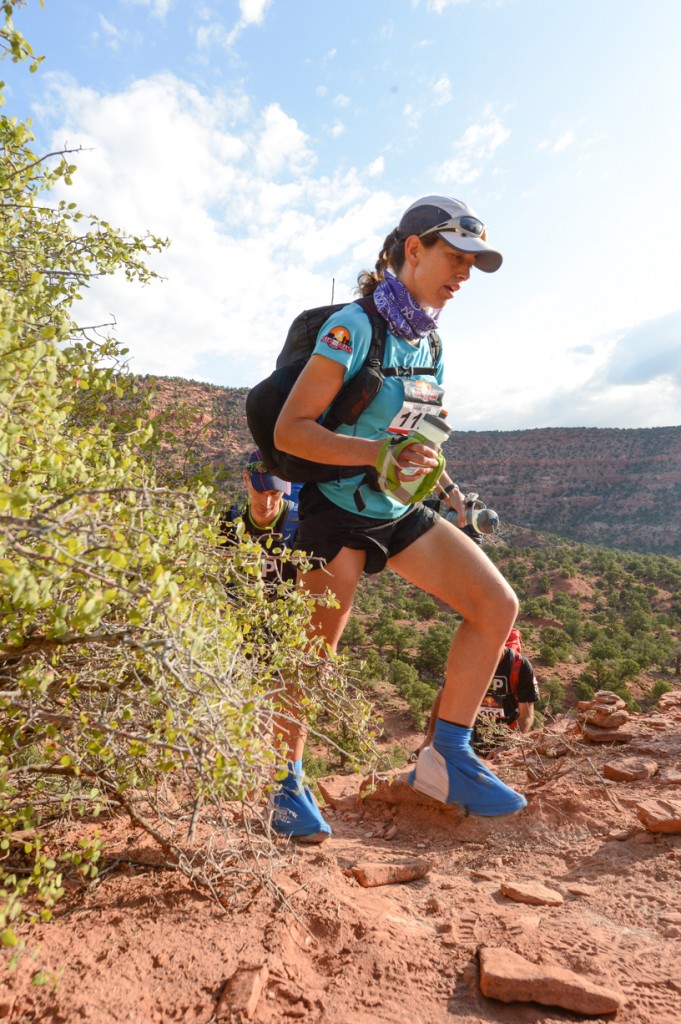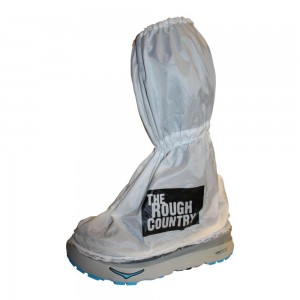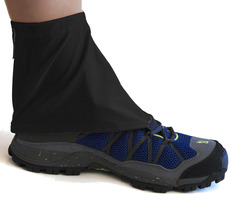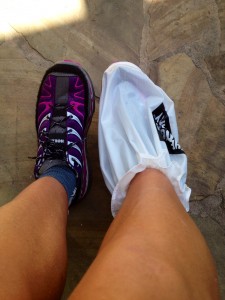A few weeks ago, I wrote a story for Trail Runner all about gaiters, those fabric coverings intended to keep dirt, pebbles and sand out of your running shoes. For ultra-long runs, it’s important to keep debris out of your shoes because it causes friction that contributes to blisters, and a shoe full of sand will weigh you down.
The story went into depth about different designs—some homemade—for full-cover gaiters used for running in deep sand. I concluded that I would experiment with different gaiter designs for the upcoming Grand to Grand Ultra, since I was unhappy with my gaiter choice when I did the event in 2012. Back then, I ordered full-cover gaiters from The Rough Country that felt too hot and too tight around my feet and ankles. The strap that ran underneath to secure it quickly wore out, and then the glued-on Velcro around the base of my shoe (used to secure the gaiter to the shoe) started to peel off and flap up.
Plus, they looked ridiculous, as if I had miniature circus tents covering each foot.

The gaiters in action in 2012’s Grand to Grand. I didn’t really need them on harder-packed, rocky terrain like this, but I needed them to keep sand out when we ran over dunes and through deep-sand trails.
This post is an epilogue to that recent article (which you can read here)—how I finally got gaiters.
First, I ordered Supplex fabric (a type of Lycra) online, along with drawstrings and clasps. I wanted to find a seamstress to make ones just like these, which G2G RD Tess Geddes had custom made to use in the Marathon des Sables (photo courtesy of Tess).
I made the mistake of measuring wrong and ordering more than twice the fabric I needed, and with shipping it came to $42. Oops. Then I called around to several seamstresses who said that Lycra is a nightmare to sew with and requires a special machine that they didn’t have. Frustrated, I went back online to see if I could find a gaiter for sale that would be close to Tess’s custom design.
It turns out The Rough Country has a different and, in my view, better design than what I used in 2012: “Silkworm Gaiters” available for $40 plus shipping through the Racing The Planet store. The product description read, “The Silkworm gaiter has been designed specifically for desert running and walking. The concept is based on the homemade gaiters desert runners have used for years to fight the battle of keeping sand and debris out of shoes.” I liked how lightweight it looked, but I didn’t like how high up the calf it goes. I figured I could modify that height somehow, so I ordered it and hoped it would arrive from Hong Kong in time.

The Rough Country Silkworm Gaiter, which features two drawstrings: one just above the ankle and another higher up the calf.
The gaiters arrived about a week later, and to my surprise they were only fabric without Velcro or any other way to attach it to the shoe. I realized I’d need to buy Velcro and find a seamstress to attach one side of the Velcro (the “hook” side) to the inner side of the gaiter base, and a cobbler to sew the other side of Velcro (the “loop” side) around my shoe.
In my Trail Runner article, some desert runners suggested skipping the Velcro attachment altogether and gluing or sewing the gaiter fabric directly onto the shoe. I didn’t want to do this, however, because I only plan to use these full-cover gaiters on very sandy stretches of the course. For the stages where we run through forests and on hard-pack road, I will use a regular, smaller gaiter made by Running Funky, which looks like this:
Thankfully I found a local seamstress able to sell me Velcro and modify the gaiters. I told her I didn’t want so much fabric going up my calf—I only wanted the gaiter to cover my shoe and go up above my ankle—so we decided to cut the top part of the gaiter off and sew a hem one inch above the lower drawstring. She charged me $30 for the cost of the Velcro and her sewing.
Then I went in search of a cobbler who had a machine capable of sewing a strip of Velcro around my shoe, eliminating the need to glue it (since even Shoe Goo and Gorilla Glue tends to fail after a few days in the hot desert). I called and went to three different shoe-repair places until one nice man finally said he’d give it a try. I brought in one of my old, worn-out Hokas and asked him to practice on that one first. He said, “That’ll be $20.” OK … I was willing to pay for a prototype. A few days later, I went back and saw what he had done—and it looked perfect!
I handed him my brand-new Hokas and hoped he wouldn’t screw them up. “That’ll be $40,” he said. (Geez, I thought, this is adding up!)
A few days later, I went back and got the Hokas. They came out great, and when I put them on, they felt the same as if they didn’t have Velcro running around them.

My new Hoka Stinson shoe with a strip of Velcro sewn around it, which is how the base of the gaiter will attach.
Today I picked up the finished gaiters from the seamstress, and ta-da—it all works! Here’s the final result:

The modified Rough Country Silkworm Gaiter with the top part shortened and a Velcro strip sewn on its inside base.
I’m happy with how these funny-looking gaiters (or maybe I should call them “booties”?) turned out because the fabric is very lightweight and breathable. They’re easy to get on and off, yet the attachment is secure enough to keep out sand, and the Velcro won’t fall off. Also, they weigh next to nothing and will fold up easily to fit in my pack on the times when I choose to wear the smaller Running Funky gaiters instead of these full-cover ones.
OK, now that I’ve exhausted this subject, I’ll turn back to the task of getting my work and family life in order so I can leave one week from tomorrow! I travel to Vegas on Thursday, Sept. 18; spend Friday in Kanab, Utah, getting acclimated and going through a gear check; shuttle to Camp 1, next to the Grand Canyon, with the other competitors on Saturday; and the race starts Sunday, Sept. 21.
As mentioned in my last post:






[…] How to make your own awesome (and gulp, expensive) gaiters. […]